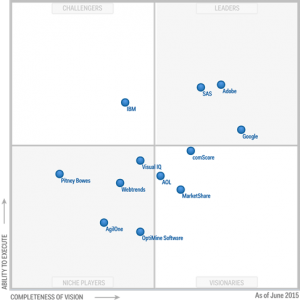
Digital marketing analytics has evolved over nearly two decades, per Gartner, and has beginnings with Web analytics developed to analyze server logs. Much has changed and a broader digital marketing analytics ecosystem has evolved into its own right, so Gartner saw the need to evaluate providers of digital marketing analytics solutions.
In their inaugural Magic Quadrant for Digital Marketing Analytics, Gartner specifically cited four areas of development to take note of: channel convergence, personalization & other advanced requirements, attribution & ROI, and the need for improved usability.
SAS was named a Leader in Gartner Inc.'s inaugural Magic Quadrant for Digital Marketing Analytics (DMA) - one of only three vendors achieving this distinction. According to Gartner, SAS offers "...a suite of solutions that addresses the full digital marketing analytics life cycle, including data collection, ingestion, exploratory analysis and modeling, simulation testing and optimization, decisioning, and measurement".
What is Digital Marketing Analytics?
Digital marketing analytics platforms are specialized analytic applications used to understand and improve digital channel user experience, prospect and customer acquisition and behavior, and to optimize marketing and advertising campaigns, with an emphasis on digital channels and techniques. They are stand-alone, end-to-end platforms, performing functions from data collection through analysis and visualization. They have demonstrated relevance to marketing through their ability to collect and ingest data from common marketing sources, provide tools for standard marketing analytics use cases, and have significant adoption by marketing practitioners.
Five Areas of Digital Marketing Analytics
As Gartner defines it, digital marketing analytics encompasses five key areas. These areas represent the crucial ways analytics practitioners and software tools are required to support marketing and advertising efforts to deliver more effective, timely and personalized cross-channel experiences.
Data Integration: Marketers must be able to analyze data that sits on different systems and in different locations in a wide range of forms and formats, including structured and unstructured datasets. In addition to the ability to collect data from channels such as websites and mobile apps, and to connect to outside sources via APIs and other methods, marketers need ways to manage and filter data and metadata.
Exploration: Marketing analytics is the discipline of finding useful patterns in data that can be applied to improve marketing and advertising. As such, analytics platforms increasingly must do more than report results — they must provide ways for users to explore data with visualization and other tools, and to manipulate that information to deliver better insight.
Advanced Models: Moving beyond data exploration, marketing analysts are turning to advanced techniques, many of which are imported from sister disciplines such as business intelligence (BI). Predictive analytics and machine learning, in particular, are providing a rich mine of methods to improve offers, advertisements and customer experiences, and text and graph analytics are improving insights in areas such as voice-of-customer and social marketing.
Extensibility: Marketing is action-oriented, and its leaders have no budget for "navel gazing." Marketing analytics activities are expected to lead to action, and for this reason supporting tools must easily support common active channels. In practice, this support requires platforms to be easily connected to systems such as multichannel campaign management, email, Web content management, social marketing and advertising technology.
Measurement: Determining the true impact of individual marketing and advertising tactics has long been a goal of marketing leaders, and a class of attribution and marketing-mix modeling tools address this need. Gartner believes this category is in transition, with many large players adding advanced measurement capabilities, through acquisition (Google and Adometry, AOL and Convertro) or native development; and attribution (bottom-up) and marketing-mix modeling (top-down) approaches converging, often in the same platform.
What sets SAS apart is that we provide all of the above combined with advanced analytical functionality around predictive analytics, campaign management and campaign optimization embedded within the digital marketing analytics process. So if you and your organization are in need of digital marketing analytics solutions, SAS is your one stop shop. Feel free to read the full report for more detail! When you're ready to explore some more, you're always welcome to reach out and contact us, or start with our Customer Intelligence home page.


1 Comment
Pingback: Digital marketing, analytics, & making personalization delicious